Source: Zhou Ziheng
Despite recognizing that the U.S. economy is “cooling,” with unemployment beginning to rise and economic activity weakening, the Fed did not cut its policy rate from its current high of 5.25-5.5% at its late July meeting.
The problem facing the Fed, as always, is to strike a balance between keeping borrowing costs high to hold down inflation and causing households to spend less and businesses to cut investment and employment because of high borrowing costs.
The Fed, like other central banks in major economies, targets price inflation at a meaningless 2% per year; the difference is that the Fed has a "dual mandate" to try to maintain employment and economic growth while reducing inflation. Can the Fed achieve this dual mandate? The Fed likes to claim that it can; the consensus among mainstream economists is that the Fed will achieve the "Goldilocks scenario" of low inflation and low unemployment and moderately solid economic growth.
The Goldilocks principle (English: Goldilocks principle), also known as the Goldilocks effect, comes from the fairy tale "The Three Little Bears" by British writer Robert Southey. It tells the story of a blonde girl named Goldilock who went into the mountains to pick mushrooms and accidentally broke into the bear house. While the father bear, mother bear and the little bear were out and had not returned yet, the blonde girl enjoyed all kinds of delicacies in the kitchen, then lay comfortably on the bear bed and fell asleep in a daze, and had a beautiful dream. In the house occupied by the blonde girl, each bear has his own preferred bed, food and chair. After stealing three bowls of porridge, sitting on three chairs and lying on three beds, the blonde girl felt that the porridge that was not too cold or too hot was the best, and the bed and chair that were not too big or too small were the most comfortable. Until one day, the three bears came back, and it turned out that the house belonged to the three bears, and the blonde's happy life was gone forever.
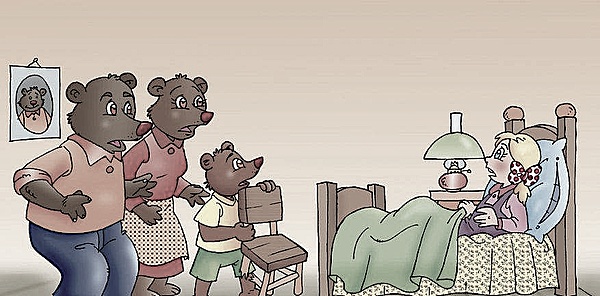
The Goldilocks Principle: Not Too Hot, not Too Cold
(Jinse Finance Note: The title can be translated as: The Goldilocks Principle: Not Too Hot, Not Too Cold)
If the dual mandate is achieved, the Fed’s interest rate policy will not be affected. As I have pointed out many times before, monetary policy is supposedly used to manage “aggregate demand” in the economy by raising or lowering the cost of borrowing (whether for consumption or investment). However, the recent experience with the surge in inflation since the end of the pandemic in 2020 is stark. The reason for the rise in inflation is weakened and blocked supply chains and the slow recovery of manufacturing production, not because of “excess demand” caused by a government spending spree or “excessive” wage increases, or both. Moreover, once energy and food shortages and prices subside, global supply chain congestion decreases, and production begins to pick up, inflation will begin to subside. Monetary policy has little to do with these movements.
Contrary to the hopes and expectations of Fed Chairman Jay Powell and all mainstream economists, trends in the U.S. economy suggest that the dual mandate is unlikely to be achieved. First, inflation remains "sticky," well above the target annual rate of 2%. The Fed likes to measure U.S. inflation based on the core Personal Consumption Expenditures (PCE) price index. This is a complex measure that excludes producer prices, energy, and food prices—a hardly an accurate measure of price increases for most Americans! Even so, core PCE is currently at 2.6%, down from a peak of 5.6% in 2022, but still well above 2% and 2019 interest rates.
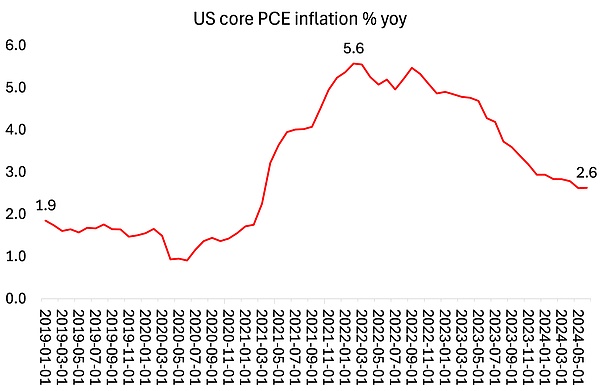
Headline consumer price inflation is running well above the Fed’s target. At 3.0%, it’s down from a peak of 9% in 2002, but still a full percentage point above the Fed’s illusive target and twice as high as 2019’s rate.
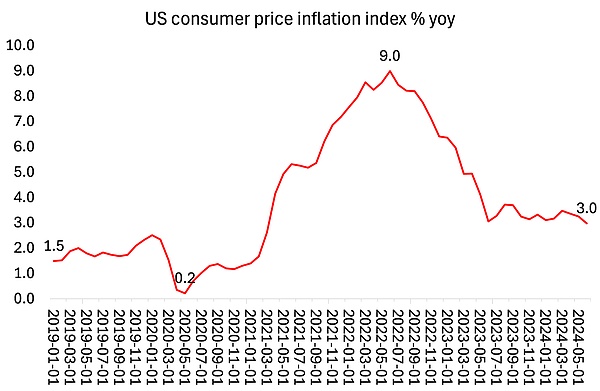
As you can see, despite the optimistic talk of inflation from mainstream economists, the CPI rate seems to be hovering around 3% with little sign of falling further. The reasons are clear to me. First, as I have argued before and above, inflation is not driven by "excess demand" but by insufficient supply (i.e., slow productivity growth and high commodity prices). Second, the prices of many products in the U.S. economy have risen sharply over the past two years, but this does not seem to have affected the official price indicators.
Housing costs, health care and car insurance in particular have all risen sharply. As a recent Financial Times article acknowledged: “Both are partly the product of the pandemic supply shock – reduced construction and shortages of car parts – which are still working their way through the supply chain. Indeed, more expensive car insurance now is a product of past car cost pressures. Demand is not the core issue; high interest rates can’t help.”
There is another measure of inflation in the US economy, called the sticky-price Consumer Price Index (SCPI), which is calculated based on a group of goods and services included in the CPI whose prices change relatively little and are therefore not as much affected by changes in demand. This index again shows a higher inflation rate, currently at 4.2% year-over-year, three times higher than at the beginning of 2021.
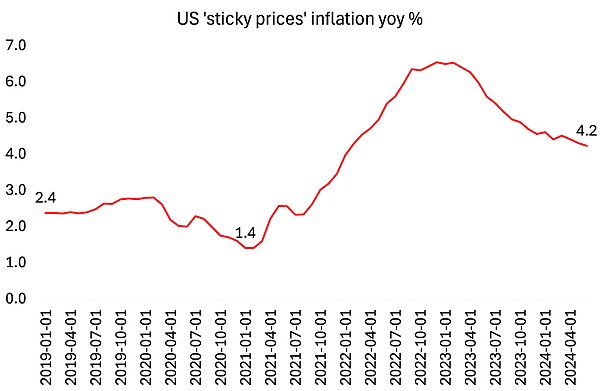
This indicator shows that inflation is deeply ingrained into the economy, with businesses taking every opportunity to raise prices and never letting go of any opportunity to lower them. Remember, the prices of goods and services purchased by American households have risen by an average of 20% over the past three years - so the current slowdown in inflation means that prices are still rising sharply, but not as quickly. Over the past few years, rising prices have eroded the real incomes of most Americans, so even if they all have jobs (mostly low-paying service jobs), their living standards have gone backwards.
So, contrary to the Fed’s rhetoric, the “battle against inflation” has not been won. As a result, the Fed has not lowered its policy rate. But by not lowering it, the Fed’s high policy rate is keeping borrowing rates high, hitting the profits of small businesses that typically must borrow to invest and hire employees, as well as credit card and mortgage rates for households.
This raises the question of whether the U.S. economy is actually growing steadily, thus avoiding any recession caused by high interest rates squeezing profits. Recently, the estimate of annualized growth of real GDP in the second quarter of the United States of 2.8%, faster than the 1.4% in the first quarter, attracted a lot of attention. But this headline number hides many holes.
First, this is an “annualized” growth rate, which means that the quarterly growth rate of real GDP in the second quarter was actually only 0.7%. Second, the overall growth rate includes the following major contributions: health services (0.45 percentage point); inventories (0.82 percentage point); and government spending (0.53 percentage point). Health services is actually a measure of the rising cost of health insurance, rather than a measure of the quality of health care, and this cost has soared over the past three years. Inventories mean unsold stocks of goods, in other words, unsold output; and government spending, which mainly goes to weapons manufacturing, is hardly a productive contribution.
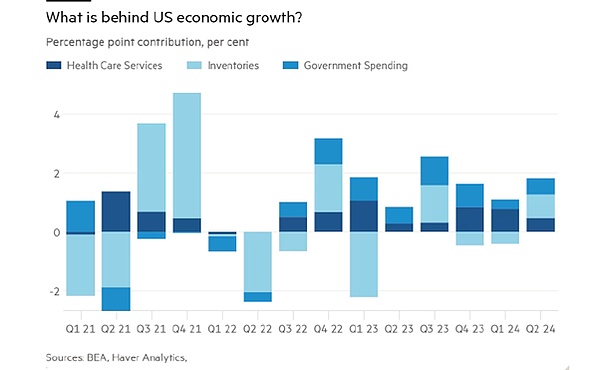
If you strip all that out and look at what are called “actual final sales to private domestic buyers,” which is a much better measure of U.S. economic activity, there has been no improvement from the weak first quarter. In fact, real final sales growth was zero in the first half of the year, and is about 2% for all of 2023.
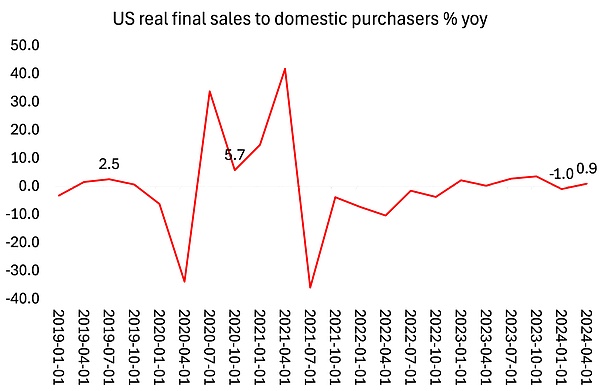
Sales growth to consumers has been outperforming real personal income growth. On average, U.S. households are seeing only a very small increase in real income after two years of declines. Real disposable personal income (personal income after inflation and taxes are deducted) grew at an annualized rate of just 1%, slower than in the first quarter.
No wonder U.S. consumer confidence has fallen to its lowest level in eight months. The University of Michigan's consumer sentiment index had a final reading of 66.4 for July, the lowest since November. Mainstream economists, puzzled by the fact that consumer spending and incomes are booming, call it a "sentiment recession." American households don't seem to realize they're doing just fine! But "high prices continue to weigh on attitudes, especially among those with lower incomes," said Joanne Hsu, director of the Michigan Survey.
That’s the situation on the consumption side. On the production side, the situation is not much better. The US corporate earnings season has begun, and there is bad news on all sides, especially from the big technology and social media companies that dominate the US stock market and account for most of the corporate sector’s profits.
Four of the so-called "Big Seven Tech Stocks" that have driven the U.S. stock market higher over the past nine months ended the week in "correction territory," with share prices down more than 10% from recent highs. Two others -- Microsoft and Amazon -- saw declines approaching double digits, signaling a correction. From "Big Seven Tech Stocks" to "Big Five Tech Stocks"!

Big tech companies have invested their fortunes in the expected huge profits from artificial intelligence. They have initiated unprecedented investments, becoming the main driver of business investment in the US economy. Microsoft said that "we expect capital expenditures to increase significantly this year" and that "AI demand is slightly higher than our available capacity in the short term." Amazon said that strong demand for cloud services and artificial intelligence means it will "significantly increase" capital expenditures. Meta said that artificial intelligence will drive increased investment this year and in 2025. But doubts are beginning to emerge about whether artificial intelligence can quickly achieve higher profits, and if big tech companies start to reduce spending, then this will have repercussions on the corporate economy. There is increasing discussion about "tail risks" in the stock market.
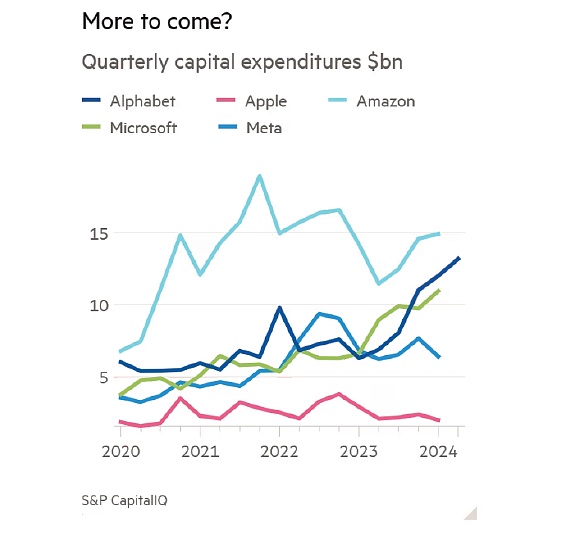
UPS also fell 12%. The delivery company is often seen as a bellwether for the broader economy after it cut its forecast for the rest of the year. Since the end of the pandemic, investment in transportation equipment has increased significantly in response to the increase in global output. But this situation seems to be coming to an end.
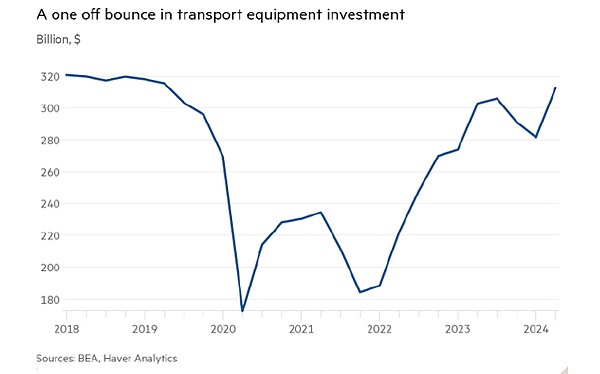
As for employment, the overall picture remains weak job growth and rising unemployment. ADP data showed that payrolls for small businesses employing 20-49 employees were negative 88,000 year-on-year. Except for large businesses, payrolls for all other businesses showed a negative growth trend.
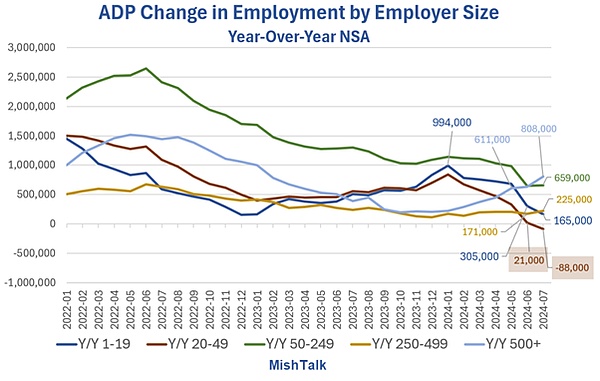
In fact, forward momentum in economic activity is weakening.
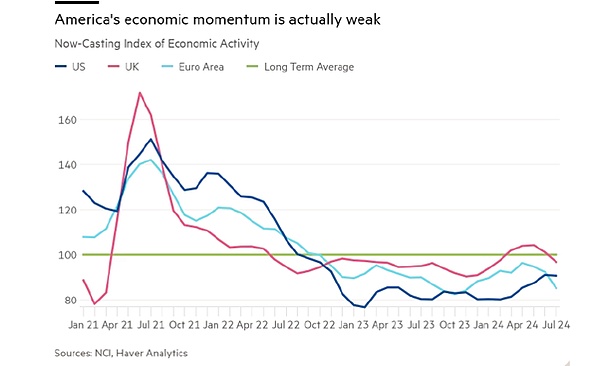
The reality is that the US economy may be the best performing of the G7, but it is not booming. Even so, the situation in Europe and Japan is much worse - I will come back to this in a later article. The situation in the UK is so bad that the Bank of England has decided to cut its policy rate now. The UK headline inflation rate has fallen sharply to 2%, but this is only because the UK economy is stagnant.
In summary, the Fed will almost certainly start cutting its policy rate at its September meeting – and it has already hinted at this. But that’s because it has no choice but to avoid economic stagnation or even recession, as the Bank of England is already facing. As a result, the Fed will have to accept that it will not be able to achieve its 2% inflation target. And American households will face more inflation in stores and key services.




